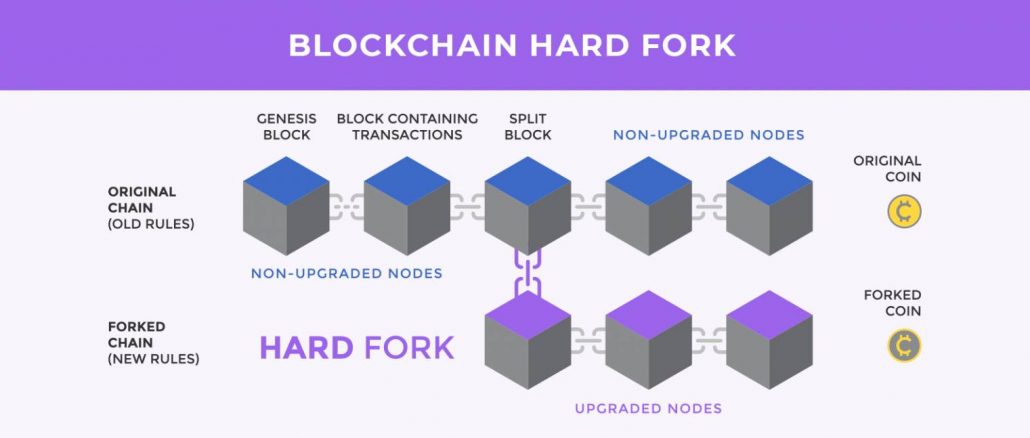
Sooner or later, any emerging cryptocurrency needs to make global changes that change the rules of its operation. A hardfork is an update of a cryptocurrency protocol that significantly changes the principles of its functioning and is incompatible with the previous version of the network. In this article, let’s examine what a hardfork is, why it is needed, and what opportunities and dangers it brings to cryptocurrency.
Content
- What is a cryptocurrency hardfork?
- The process of conducting a hardfork
- What is the difference between a hardfork and a softfork?
- Planned and controversial forks
- What is the purpose of a hardfork?
- Who can initiate a fork?
- Hardfork initiation
- How does a hardfork affect the price of a cryptocurrency?
- Advantages and disadvantages of cryptocurrency hardfork
- Popular cryptocurrency hardforks
- Conclusion
What is a cryptocurrency hardfork?

Blockchain networks, unlike regular programs, cannot update at the click of a button. Cryptocurrency, as a decentralized network, operates through the work of nodes – members of the network that process transactions for a certain fee. For successful functioning, all nodes work on a single protocol and updating the network requires their full consent.
Such updates in the cryptocurrency industry are called forks. The very notion of fork means creating a clone of a cryptocurrency based on its source code taken from open sources. That is, a fork is a full copy of a coin that has not been altered.
Hardfork, in simple terms, is an update of the blockchain’s programming code by creating a new chain of blocks. The cryptocurrency protocol defines the principles of network operation (consensus algorithm, transaction processing methods, node interaction). A hardfork, on the other hand, is aimed at changing the rules of the protocol.
The process of conducting a hardfork
The update takes place from a predeclared block of the network. If nodes accept the hardfork this block becomes the first for the new blockchain, if nodes do not want to change – the hardfork is canceled and the network just continues to work.
A new chain is formed when a hardfork takes place, that is, the network is split into two blockchains that are independent of each other. The network with the “original” protocol is unchanged, continuing to operate under the old rules. But all the nodes that make it work completely leave it, making its existence impossible. The second network begins to operate under the updated rules.
In most cases the old network dies out, but sometimes not everyone in the community agrees to the changes. Then the old version of the protocol gets a chance to “survive” by becoming a new coin with a different name. A similar situation took place during the Ethereum Classic fork
What is the difference between a hardfork and a softfork?
There are two types of updates, hardfork and softfork, which essentially correspond to “hard” and “soft” implementation of code changes, but it depends on the specifics of the update.
With softforks, updates are made to the network without restricting the operation of the old protocol, that is, nodes that have not switched to a new protocol, can continue to provide the network with the old principle, but only as long as their work does not violate the rules of the updated network. That is, a softfork is a milder version of the changes – the old nodes, although able to work, but only within a limited scope, which reduces their efficiency and smoothly leads to an upgrade.
In the case of a hardfork, the network does not foresee the ability to work on the past version and requires the creation of a new branch of the blockchain. It must be supported by all nodes in the network, otherwise it will be cancelled or lead to the creation of a new cryptocurrency. With a softfork, there is no such risk, but it cannot allow the network to start making fundamental changes.
That is, a hardfork is the only option for global changes in the network’s protocol and functionality.
Planned and controversial forks
Hardforks can be either planned or unplanned.
With planned changes, network nodes are willing to upgrade voluntarily on the announced day, leaving behind outdated rules. In this case, there are usually few dissenters and even if they remain on the abandoned branch of the blockchain, its existence becomes impossible due to insufficient hash rate.
Heated debates or unplanned hardforces (as in the case of the Ethereum Classic hardforge discussed later) often result in a split community, resulting in two functioning networks moving in different directions.
What is the purpose of a hardfork?
A cryptocurrency hardfork is first and foremost an update that aims to improve the performance of the network. Thus, a hardfork can be used for such purposes:
- Fixing network bugs – detected bugs need to be solved and if old nodes can’t continue working after fixing them, the network needs a hard fork.
- Adding new features – for example, introducing smart contracts or radically changing the algorithm of operation.
Who can initiate a fork?
Many cryptocurrencies, including bitcoin, have open source code, and therefore it is not difficult to create a new one.
The most famous bitcoin forks are Litecoin (LTC), which as of December 2021 is ranked 18th in the cryptocurrency ranking, and DASH, ranked 79th.
Hardfork initiation
Anyone can initiate a network hardfork, as well as a softfork. Usually, the initiator is a well-known person in the cryptocurrency world or an entire community – a team of developers, a pool of miners, or a community of coins.
In any case, in order to conduct a hardfork, it is necessary to convince as many participants of the network as possible of its necessity. Often, it is the rift in the community that leads to a hardfork, and consequently to the emergence of a new cryptocurrency.
The most famous coins that emerged as a result of bitcoin’s hardfork are Bitcoin Cash and Bitcoin Gold.
How does the hardfork affect the price of the cryptocurrency?
There is no clearly traceable effect of the hardfork on the cryptocurrency price. It largely depends on its characteristics – the reason for its initiation, the level of acceptance by the community.
So, a positive attitude of all participants of the community and important changes that strengthen the position of the cryptocurrency in the market can have a positive impact on the currency rate. But it is far from necessary and the only thing that experts agree on is that global changes in the protocol during the hardfork can only provoke excessive volatility of the asset.
And this applies only to large coins – hardfork of cryptocurrencies with low capitalization usually has no effect on their rates or it may even turn out to be another fraud attempt.
Advantages and disadvantages of cryptocurrency hardfork

The consequences of a hardfork can both have a positive effect on a cryptocurrency’s functioning and rate, and a negative effect.
Advantages of hardforks
- A dramatic change in network protocol aimed at the evolution of the crypto-asset. If successful, all users completely migrate to the new network. The previous version dies out due to its uselessness and lack of working nodes;
- Improving the network performance and changing the conditions of its operation – increasing the bandwidth, changing the rules for mining rewards, optimizing the principles of node interaction;
- Fixing critical bugs, improving security protocols;
- Some users consider a hardfork as a chance to earn money – so when the blockchain is split, the number of coins also doubles, and if the previous version is still functional, the user can withdraw and sell these coins.
Disadvantages of hardforks
- With hardfork changes, it is difficult to predict how a hardfork will affect the performance of the network and which network will remain the main one. There is always the possibility of critical errors that can no longer be fixed by rolling back the system. In this case, network members will have to opt for the previous version of the network, i.e. the branch without the upgrade that appeared at the time of the network split;
- A hardfork often causes the community to split into two groups for and against the change. In this case, even if the hardfork is held by a majority, the “old” network has every chance of “surviving” and continuing to function. Of course, a splintering of a large number of network nodes can negatively affect the main cryptocurrency network;
- Hardfork can cause volatility of the asset, which can lead to loss of funds.
Popular cryptocurrency hardforks
During a hardfork, the network branches off, creating two versions that operate under the old and new protocols. If there are enough nodes of the old version of the network to ensure its functionality, it remains and continues to work under the new name.
It is worth understanding that the new coin working under the old protocol is not the goal of the hardfork, but its byproduct, which has a chance of commercial success.
Bitcoin hardforks
The bitcoin network has seen many hardforks over the course of its existence. The very first one was launched in mid-2015 to increase network capacity by increasing block size. The Bitcoin XT spin-off coin did not gain the necessary number of miners for its functioning.
- Bitcoin Cash (BCH) is the most successful coin since the hardfork of bitcoin in August 2017. The reason for its emergence was a community split over the controversy over the need for a larger block size.
Interestingly, BCH also had a post-hardfork hardfork that created two more branches – BCH and BCHA. Bitcoin Cash hardfork has a market capitalization of $8.3 billion as of December 2021 and is ranked #24 in the CoinMarketCap cryptocurrency ranking with a value of $442.
- Bitcoin Gold (BTG) – this coin also appeared in 2017 at the initiative of a pool of miners promoting the introduction of an update to the use of video cards for mining under the slogan “let’s make bitcoin decentralized again.” As of the end of 2021, the coin is worth $43 and ranks 112th in capitalization.
- Bitcoin Diamond (BCD) – Hardforks of bitcoin have historically taken place under the slogan “going back to the roots.” So, too, BCD emerged in November 2017, thanks to the desire of bitcoin supporters to ensure complete anonymity of transactions. In addition, there was an increase in bandwidth and the number of coins to be issued. BCD is worth $1.31 in December 2021 and ranks 189th on CoinMarketCap.
Ethereum hardforks

There have also been quite a few hardforces in the history of ethereum’s development. For example, the first one occurred in March 2016, just under a year after the blockchain’s launch. This update stabilized the blockchain and brought it closer to greater decentralization, by removing the canary contracts feature that allows developers to undo user actions.
Ethereum Classic
One of the most negative developments in the history of ethereum occurred in 2016 when developers launched an investment project to raise funds based on smart contracts within the core network. The smart contracts software code contained a critical vulnerability that enabled fraudsters to steal $50 million in assets.
The stolen funds, like all other user coins, were blocked for 28 days, giving them a chance to be recovered. To get it back, it was decided to launch an unplanned hardfork of ether, which eventually led to a network and community split, and the emergence of a new coin, Ethereum Classic.
Byzantium, Constantinople and London
Unlike bitcoin, whose hardforks constantly led to new coins, ether has a more coherent community. Thus, over the years, there have been several more successful planned ether hardforks:
- Byzantium – launched in October 2017, it was aimed at optimizing network commissions, introducing a mechanism for parallel processing of blockchain transactions and moving a “complexity bomb” – a mechanism to gradually increase the complexity of mining.
- Constantinople – After two cancellations, an ethereum hardfork was held in early March 2019. This update improved smart contracts and optimized virtual machine performance, also reduced rewards for miners and moved the complexity bomb again.
- London – The ether network’s hardfork in early August 2021 completely changed the rewarding mechanism for miners. After the update, each block has a fixed commission and a portion of it is automatically burned off, keeping asset inflation in check.
All of these headforks, including softer updates such as Altair, are preparing ether for the beginning of a new era called Ethereum 2.0.
Cardano hardforks
The first “third generation” cryptocurrency and the world’s seventh largest by capitalization, Cardano has always attracted investors with its elaborate roadmap, but most importantly, with the urgency to follow it. ADA’s hardforks never lead to the creation of a new coin because of the special system of combining old and new blocks.
- Shelley is the first major update for the Cardano network. It was activated in July 2020 and was aimed at fully decentralizing the network and enabling staking capabilities. Since then, the network has switched to the Ouroboros consensus algorithm.
- Mary – Cardano’s hardfork, which opened up the ability for users to create their own tokens without using smart contracts, was launched in March 2021.
- Alonzo – the last major update that brought the cryptocurrency into the Goguen era happened in September 2021. With its launch, smart contracts are finally opening up for the network, allowing the creation of decentralized applications based on the network.
Conclusion
Hardforks can lead a cryptocurrency to unexpected consequences: splitting the community and creating a competing coin, but their goal – the development and improvement of technology – is more important than all the dangers. The ever-growing cryptocurrency market is gaining more and more supporters, changing the rules of the financial world, and only the best platforms and coins that are ready to change will become its foundation.

Be the first to comment